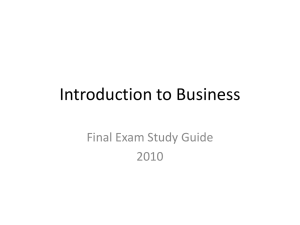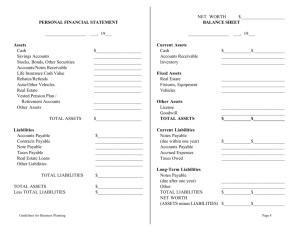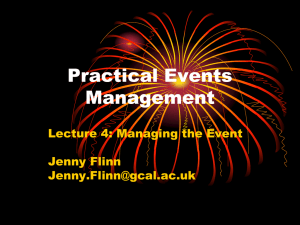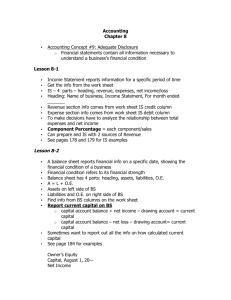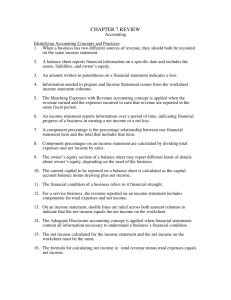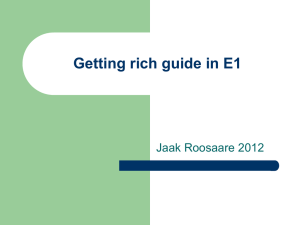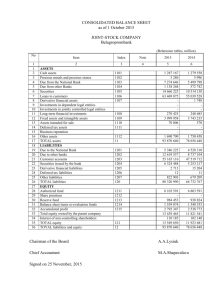Cash Flow & Balance Sheets
advertisement
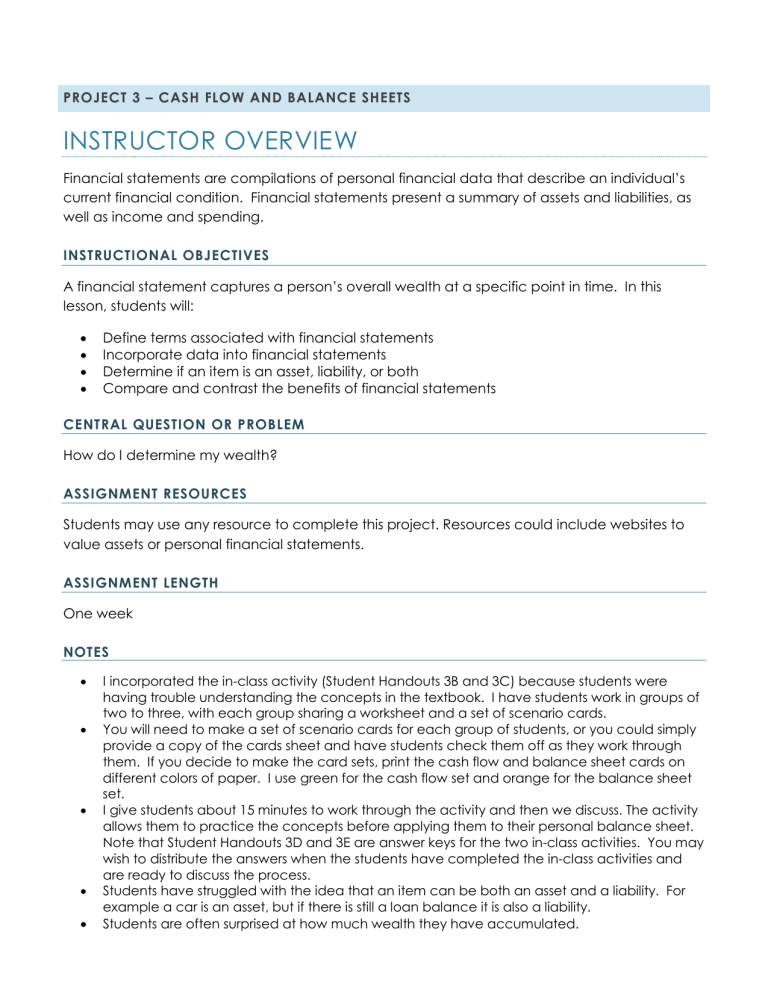
PROJECT 3 – CASH FLOW AND BALANCE SHEETS INSTRUCTOR OVERVIEW Financial statements are compilations of personal financial data that describe an individual’s current financial condition. Financial statements present a summary of assets and liabilities, as well as income and spending. INSTRUCTIONAL OBJECTIVES A financial statement captures a person’s overall wealth at a specific point in time. In this lesson, students will: • • • • Define terms associated with financial statements Incorporate data into financial statements Determine if an item is an asset, liability, or both Compare and contrast the benefits of financial statements CENTRAL QUESTION OR PROBLEM How do I determine my wealth? ASSIGNMENT RESOURCES Students may use any resource to complete this project. Resources could include websites to value assets or personal financial statements. ASSIGNMENT LENGTH One week NOTES • • • • • I incorporated the in-class activity (Student Handouts 3B and 3C) because students were having trouble understanding the concepts in the textbook. I have students work in groups of two to three, with each group sharing a worksheet and a set of scenario cards. You will need to make a set of scenario cards for each group of students, or you could simply provide a copy of the cards sheet and have students check them off as they work through them. If you decide to make the card sets, print the cash flow and balance sheet cards on different colors of paper. I use green for the cash flow set and orange for the balance sheet set. I give students about 15 minutes to work through the activity and then we discuss. The activity allows them to practice the concepts before applying them to their personal balance sheet. Note that Student Handouts 3D and 3E are answer keys for the two in-class activities. You may wish to distribute the answers when the students have completed the in-class activities and are ready to discuss the process. Students have struggled with the idea that an item can be both an asset and a liability. For example a car is an asset, but if there is still a loan balance it is also a liability. Students are often surprised at how much wealth they have accumulated. PROJECT 3 ASSESSMENT CASH FLOW AND BALANCE SHEET RUBRIC This project has a total value of 20 points. The student did not follow directions. (minus 2) The student created a cash flow statement that was complete. The cash flow statement provided detail of income and expenses. (plus 10) The student attempted to create a cash flow statement but they were not thorough. (plus 5) The student did not attempt. (0 points) The student created a balance sheet that was complete. Detailed information was provided for assets and liabilities. (plus 10) The student attempted to create a balance sheet but they were not thorough. (plus 5) The student did not attempt. (0 points) The assignment was late. (loss of one point per day) Total 2 STUDENT HANDOUT 3A PROJECT 3 OVERVIEW: CASH FLOW AND BALANCE SHEETS HOW DO I DETERMINE MY WEALTH? Financial statements capture your overall wealth at a specific point in time. In this lesson, you will: • • • • Define terms associated with financial statements Incorporate data into financial statements Determine if an item is an asset, liability, or both Organize personal financial data into a spreadsheet to determine net worth Financial statements are compilations of personal financial data that describe an individual’s current financial condition. They present a summary of assets and liabilities, as well as income and spending. ASSIGNMENT INSTRUCTIONS After completing the in-class activities (Student Handouts 3B and 3C), use the answer keys to check your work (Student Handouts 3D and 3E). Once you are comfortable with how to categorize assets, liabilities, income, and expenses, you will use the templates provided (Student Handouts 3F and 3G) to create your own financial statement. Points to remember: • • • • • A cash flow statement shows how much money has come in as income, and how much money has left in expenses. By subtracting your expenses from your income, you can tell if you have a surplus or a deficit in income. Fixed expenses recur at specific intervals. Rent and car payments are examples of fixed expenses. Variable expenses change over time. Examples of variable expenses are food and utilities. Once you have completed entering your income and expenses, you will need to determine if you have a monthly surplus (income exceeds expenses) or a deficit (expenses exceed income). Having a budget and using a cash flow statement can help you anticipate shortages and surpluses. For example, in December your outflow will be greater than normal because you would like to purchase Christmas gifts. However, in the summer months your cash inflow may be higher because of a summer job. By using a cash flow statement, you can more easily identify the flow of income and expenses. A balance sheet is a snapshot of what is happening in your financial life. It covers your overall wealth at a specific point in time. An asset is everything you own that has monetary value. Assets can be classified as monetary (cash or near cash), tangible (personal property) or investment assets (stocks and bonds). STUDENT HANDOUT 3A 3 PROJECT 3 OVERVIEW (CONTINUED) • • • • Liabilities are what you owe. Liabilities can be classified into short-term (debt repaid within one year) or long-term (longer than one year). Remember that an asset can also be a liability. For example, a car with a value of $5,000 would be listed in the asset column. If there were an outstanding loan balance of $2,500, it would be reflected in the long-term liability column. Once you have listed the value of your assets and balances of your liabilities, you will determine your net worth. Assets – Liabilities = Net Worth By completing a balance sheet, you can easily identify strategies to increase net worth. You should update your balance sheet at least once a year. 4 STUDENT HANDOUT 3B PROJECT 3 ACTIVITY MONTHLY CASH FLOW EXERCISE Use the following scenario cards to fill out the Monthly Cash Flow Statement worksheet. You pay a $150 car payment. You receive your monthly gross salary of $2,000. You pay rent of $450 per month. You pay your medical insurance of $75 a month. You pay your renter’s insurance of $20. You pay your car insurance of $50. You pay for monthly groceries $200. Your monthly utilities are due. You owe $125. Your monthly bill for gasoline comes in and you must pay $75. It’s your mother’s birthday. You purchase a $50 present. Taxes come out of your paycheck. Federal Tax $150 State Tax $50 Social Security $150 You go to a movie with a friend that costs $10. You put $100 into savings for a vacation at the beach. You hit a pothole and have a flat tire. You must pay $75 for a new one. You go out to dinner with friends. Your bill is $25. You find the perfect outfit for your date this weekend. You pay $100 for the outfit. 5 STUDENT HANDOUT 3B PROJECT 3 ACTIVITY: MONTHLY CASH FLOW EXERCISE MONTHLY CASH FLOW STATEMENT WORKSHEET Complete this worksheet with the information from the green scenario cards. Income Gross salary Total Income Expenditures Fixed Expenses Rent Renter’s insurance Automobile loan payment Automobile insurance Medical insurance Revolving savings fund Federal income tax State income tax Social Security tax Total Fixed Expenses Variable Expenses Food Utilities Gasoline and maintenance Clothing and personal upkeep Gifts Miscellaneous Total Variable Expenses Total Expenses SURPLUS (DEFICIT) 6 STUDENT HANDOUT 3C PROJECT 3 ACTIVITY BALANCE SHEET EXERCISE Use the following scenario cards to fill out the Balance Sheet worksheet. You have $1250 in your checking account. You have $1750 in your revolving savings account. You purchased a computer last summer and it is valued at $500. You received a graduation gift of a watch and it is valued at $300. You purchased new furniture for your apartment. It is valued at $1,000, but you still owe $400. Your car is valued at $5,000, but you still owe $1,500. You owe $300 on a credit card. You have put $1,000 into a Roth IRA. You participate in your employer’s 401k program. You have saved $5,000. You need a root canal procedure at your dentist office. You owe $400. You just cashed your income tax refund of $1,000. You purchased a flat-screen TV that is valued at $500. You have $75 in cash. You have a student loan balance of $20,000. You purchase a condo for $60,000 and you owe $45,000. You and your best friend move into your new condo. They pay you $450 a month in rent. 7 STUDENT HANDOUT 3C PROJECT 3 ACTIVITY: BALANCE SHEET EXERCISE BALANCE SHEET WORKSHEET Complete the balance sheet worksheet with the information from the orange scenario cards. Assets $ Liabilities $ Monetary Assets Short-term Liabilities Savings account Credit card Checking account Medical debt Cash Other Total Monetary Assets Total Short-term Liabilities Tangible Assets Long-term Liabilities Computer Automobile loan Jewelry Home mortgage Furniture Furniture loan Automobile Student loan Television Home Total Tangible Assets Total Long-term Liabilities Investment Assets Roth IRA 401K Retirement Account Total Investment Assets Total Assets Total Liabilities Assets Liabilities Net Worth 8 STUDENT HANDOUT 3D PROJECT 3 ACTIVITY CASH FLOW STATEMENT ANSWER KEY This chart shows the answers for the worksheet associated with the green cards. Income Gross salary $2,000 Total Income $2,000 Expenditures Fixed Expenses Rent $450 Renter’s insurance $20 Automobile loan payment $150 Automobile insurance $50 Medical insurance $75 Revolving savings fund $100 Federal income tax $150 State income tax $50 Social Security tax $150 Total Fixed Expenses $1,195 Variable Expenses Food $200 + $25 = $225 Utilities $125 Gasoline and maintenance $75 + $75 = $150 Clothing and personal upkeep $100 Gifts $50 Miscellaneous $10 Total Variable Expenses $660 Total Expenses $1,855 SURPLUS (DEFICIT) $145 9 STUDENT HANDOUT 3E PROJECT 3 ACTIVITY BALANCE SHEET WORKSHEET ANSWER KEY This chart shows the answers for the worksheet associated with the orange cards. Assets $ Liabilities Monetary Assets $ Short-term Liabilities Savings account $1,750 Credit card $300 Checking account $1,250 Medical debt $400 Cash $1,000 + $75 = $1,075 Other $450 Total Monetary Assets Total Short-term Liabilities $4,525 $700 Long-term Liabilities Tangible Assets Computer $500 Automobile loan $1,500 Jewelry $300 Home mortgage $45,000 Furniture $1,000 Furniture loan $400 Automobile $5,000 Student loan $20,000 Television $500 Home $60,000 Total Tangible Assets $67,300 Total Long-term Liabilities $66,900 Total Liabilities $67,600 Investment Assets Roth IRA $1,000 401K Retirement Account $5,000 Total Investment Assets $6,000 Total Assets $77,825 Assets $77,825 Liabilities $67,600 Net Worth $10,225 10 STUDENT HANDOUT 3F PROJECT 3 ACTIVITY MY CASH FLOW STATEMENT Income Expenses $ Fixed Expenses $ Variable Expenses Wages #1 (gross) Rent/Mortgage Food (home) Wages #2 (gross) Home Insurance Food (meals away) Interest Income Real Estate Taxes Food (for entertainment) Dividend Income Vehicle Loan #1 Entertainment Sales Commissions Vehicle Loan #2 Electricity Bonuses Automobile Insurance Natural Gas Tips Life Insurance Water/Sewer Gifts Medical Insurance Garbage Collection Tax Refunds Retirement Fund #1 Cable TV Other Retirement Fund #2 Telephone Other Student Loan Payments Cell Phone Federal Income Tax Medical State Income Taxes Clothing City Income Taxes Gifts Social Security Taxes Personal Care Personal Property Taxes Personal Allowances Savings #1 Gasoline Savings #2 Vehicle Maintenance Savings #3 Education Expenses Other Charitable Contributions Other Other Other Other Total Income Total Fixed Expenses Other Other Miscellaneous Total Variable Expenses TOTAL EXPENSES SURPLUS (DEFICIT) 11 $ STUDENT HANDOUT 3G PROJECT 3 ACTIVITY MY BALANCE SHEET Assets Liabilities $ $ Monetary Assets Short Term Liabilities Cash Credit Card #1 Checking Account #1 Credit Card #2 Checking Account #2 Credit Card #3 Savings Account #1 Credit Card #4 Savings Account #2 Medical Debts Savings Account #3 Past Due Utilities Cert. Of Deposit #1 Past Due Rent Cert. Of Deposit #2 Personal Loans Money Market Acc't Other Other Other Other Other Total Monetary Assets Total Short Term Liabilities Tangible Assets Long-term Liabilities Vehicle #1 Vehicle Loan #1 Vehicle #2 Vehicle Loan #2 Home #1 Home Mortgage #1 Home #2 Home Mortgage #2 Clothing Student Loan(s) Furniture Furniture Loans Entertainment Electronics Computer Loans Home Appliances & Equip. Home Appliance Loans Computer Equipment Personal Loans Computer Software Other Jewelry Other Recreation Items Total Long-term Liabilities Personal Property TOTAL LIABILITIES Other Tangible Assets Total Tangible Assets 12 STUDENT HANDOUT 3G PROJECT 3 ACTIVITY: MY BALANCE SHEET (CONTINUED) Investment Assets Stocks Bonds Mutual Fund #1 Mutual Fund #2 Employer Retirement Account(s) IRA Accounts Life Ins. Cash Value(s) Real Estate Investments Collectibles Other Investment Assets Total Investment Assets TOTAL ASSETS NET WORTH 13

